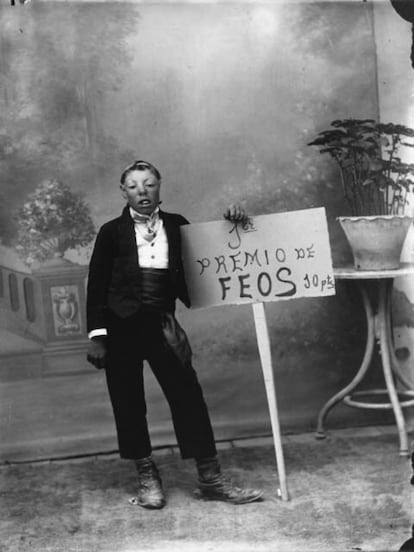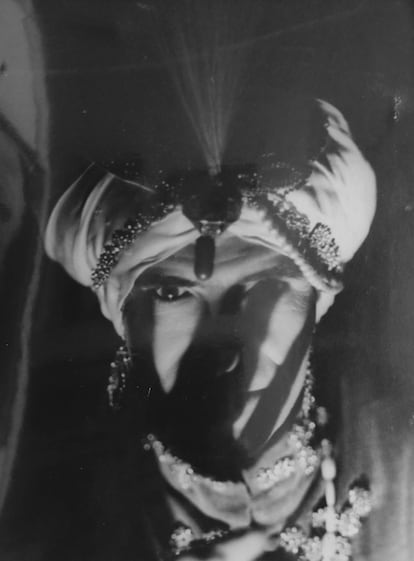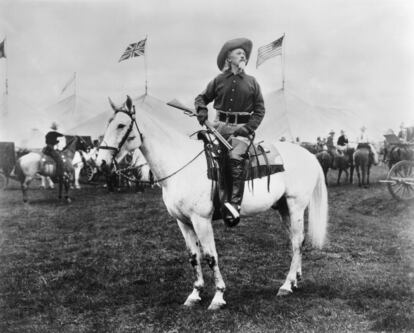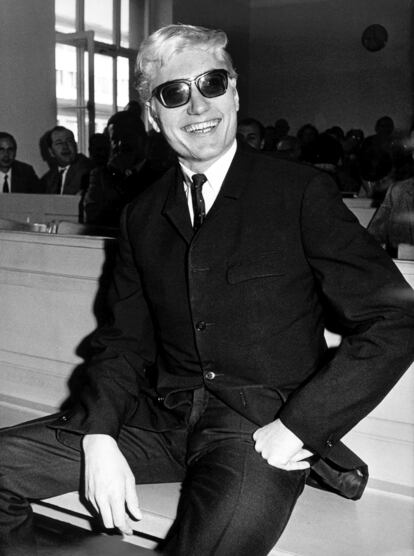Between 1987 and 1988, the Crazy Passions section of EL PAÍS’ weekly magazine brought together Spanish public figures who posed in the guise of their favorite historical figures. In this context, photographer Luis Magán met former Spanish prime minister José María Aznar, who was then premier of the regional government of Castilla y León, at the castle of Villafuerte de Esgueva in Valladolid, to photograph him dressed as the medieval knight El Cid. “Aznar got out of the official car already in costume and, according to what Luis Magán himself told me, began to speak to him in verse in the style of the [epic Spanish poem] The Song of my Cid,” says Servando Rocha, director of the publishing house La Felguera and coordinator of the book One, big and rare: Illustrated dictionary of hallucinating and hallucinating Spain (One, Great and Strange: Illustrated Dictionary of Amazing and Amazed Spain), which features a snapshot of Aznar taken during that session as its cover.
“The right and ultra-right of today are there,” believes the editor. “El Cid, Pelayo, the Visigoths, the Iberians, Isabel the Catholic… these make up the artifact that Spanish nationalism has tried to build as an identity. “A forced, histrionic, and garish identity, and always skipping the Arab period, which is of no interest to its discourse.”
The key to the book lies in the clash between the cover and the quote by the comedian Ignatius Farray with which it opens: “For me, being Spanish means not giving a shit about being Spanish […] And, with all due respect, Spaniards who take themselves too seriously have always seemed to me, paradoxically, not very Spanish.” Inspired by Luis Carandell’s Celtiberia Show (1971), La Felguera’s new volume is structured as a reference manual, from A to Z, about Spain, where the strange plays a preponderant role, often as a result of the failure in the construction of a national epic. A unity of destiny in the grotesque. “It is looking at the reality of Spain through the concave and deforming mirrors of [playwright and poet Ramón María del] Valle-Inclán,” says Rocha. “It gives continuity to other books edited by us such as Wild Spain: The other national episodes [Wild Spain: The Other National Events] and describe the basis of what we do, which has to do with memory. Our editions are a kind of great encyclopedia of anomaly.”

“We have always liked the grotesque and the atavistic,” says David Bizarro, another of the writers involved in the book and the activities of La Felguera. “We have a country with some traditions and a very crazy religious imagery. There is [dictator Francisco] Franco, who slept with the hand of St. Teresa on the bedside table. Or the use of the apostle Santiago as Santiago Matamoros (the moor-killer), who was resurrected for the Battle of the Ebro [in the Spanish Civil War, as Santiago Matarrojos (red-killer)].” The entries in One, big and rare are mostly articles by various authors published in Agent Provocateur, the publisher’s online media, which collects curious and surprising stories related to Spain, occultism, pop culture, art, or punk, among others, based on newspaper archives. “Servando always has his nose in dusty originals, he spends his life in the archives of the National Library, searching through flea markets and museums,” says his collaborator and friend of him.
Despite its title, not everything in One, big and rare — a parody of Franco’s slogan “One, great and free!” — alludes to bizarre episodes of Spanish nationalism. “There are also exciting stories of dignity and overcoming adversity, such as that of The Asturianite,” says Rocha, referring to Regina García López, who grew up without arms in early 20th century Spain, made a living in show business performing with her feet (she could play the accordion, paint and sew) and would later be repressed by both Republican and Francoist authorities.
On another level, there are cases like that of Alfonso Graña, a Galician who in 1922 traveled into the Peruvian jungle and became king of three tribes with vast domains, or that of the false fakir Daja-Tarto, a frustrated matador turned variety artist, who was capable of ingesting glass or cement. “I can think of few people who symbolize and say more about the national reality than a bullfighter fakir who changed his name from Tortajada to Daja-Tarto. He turns his name around and runs!” says Bizarro, author of these chapters. “They represent well what Ignatius says, that the more seriously you take Spain the more you are making a fool of yourself, because there is nothing more Spanish than these characters.”


Buffalo Bill in Barcelona
The example from which Rocha sets out in his prologue is the controversial cultural clash around the so-called “Black man of Banyoles,” the dissected corpse of a supposed African bushman that was exhibited in the Catalan city of the same name until the year 2000 Figures from a Catalan Socialist councilman to Kofi Annan, then-secretary general of the United Nations, pressed for his repatriation in the face of protests from a multitude of local residents, who wanted it to continue to be exhibited normally. It was a vestige of the human zoos that were common in Europe in the late 19th and early 20th centuries. Colonized peoples were exhibited, with recreations of their natural environments, for the local public to observe in places like the Retiro Park in Madrid, where 40 to 50 Filipinos were installed in 1887, as part of a General Exhibition during which at least four of them died.
It was in this atmosphere that the American explorer and hunter Buffalo Bill arrived in Barcelona in 1889, disembarking with a company consisting of more than a hundred Native Americans, 10 horses and some 200 bison. “He was in his twilight years and was already making a living as a sideshow freak, trying to cash in on his legend,” explains Bizarro. “In Spain there was expectation. He had just come from touring Europe, was well-known, sold a lot of western novels and had that heroic patina.” Although the local press warned about the alleged dangers posed by “the savages,” far from killing and raping anyone, it was they who tragically returned decimated to the US after a month’s stay, an influenza epidemic, and diseases such as smallpox. “It was like when the conquistadors went to the New World; they took the flu with them and wiped out all the tribes. Here, the American Indians arrived and many didn’t make it.”

Songs that kill
Another story that One, big and rare relates is that of Álvaro Bustos, who on January 4, 1987, made himself a stake, rubbed it in bread and garlic, and drove it into the heart of his father, whom he accused of being Satan. In the previous decade, Bustos had been the singer of a band called Trébol, which had a number one hit in 1971 with the song Carmen. After the group’s dissolution, he delved into esoteric literature. “He’s our Charles Manson, only Manson didn’t kill anyone and Bustos did,” says Rocha. “It’s still a super-wild and unpleasant episode, from someone who was very well-known at a popular level,” Bizarro observes. “I don’t know if it was a matter of addictions or mental illness, but we also have to take into account that [Franco dictatorship-era] National Catholicism was basically 40 years of giving the Evil One a hard time. “Mixing pop culture with that was a Molotov cocktail.”
In relation to the American cult leader, Rocha recalls another curiosity that does not appear in the book: “The album of Charles Manson’s songs was released here by Movieplay, a label created with capital from Opus Dei, which defines the Spain of the time. It came out in 1971 or 1972, still during Franco’s regime, with Manson already in jail [for inducing the murders of Sharon Tate and her companions in 1968].” The album, which was recorded before the crimes and had Carl and Brian Wilson of The Beach Boys as producers, was titled Lie: The Love and Terror Cultalthough in Spain it was called 12 songs composed and sung by Charles Manson, with a photo of the leader of the Family sect on the cover. “They had offered it to Hispavox and they had rejected it because of moral scruples, as did everyone who didn’t have the ultra-Catholic capital. “They cared more about morbid money.”
In another musical crossroads between the lurid and the folkloric, Bizarro dedicates a chapter to Waldemar the Vampire, one of the nicknames by which the German Waldemar Wolhfahrt was known. Arrested in Alicante in 1966, Wolhfahrt was accused of being “the Vampire of the Motorway,” a serial killer who spread terror in Europe. “He was a foreigner of dubious behavior for the canons of the time, a good-looking man, with playboy airs and sunglasses, who liked luxury and fast cars, very much like an Alfredo Landa movie,” says the author.
Wolhfahrt was released after it was proven that he was not guilty and tried to use the negative publicity to his advantage by starting a career in music. In 1968 he released a single under the name Waldemar the Vampireconsisting of the songs Benidorm and you break my heart (You Break My Heart). In another impressive turn, in 1970 he starred (now under the stage name Wal Davis) in a film entitled The Highway Vampire (The Vampire of the Motorway), where he recreated the crimes and played the killer he had been accused of being. “It’s a fascinating story with an absurdist, Tarantino-movie feel to it,” says Bizarro.

Franco’s smile
Servando Rocha has fun recalling other nonsensical articles in the book, such as the Ku Klux Klan couplet (a song from the 1920s — it is not clear if it is ironic — about girls who are repulsed by the Klan but end up seduced because their militants are “rich and good kids”), but especially with the section he devotes to fascist propaganda with erotic overtones. “For many of the photographs of [founder of the Spanish Falange] José Antonio Primo de Rivera, a strange Sara Montiel-type veil was used,” Rocha points out. in One, big and rare he quotes the words of the Falangist writer Ernesto Giménez Caballero: “Franco is the smile. His deepest secret […] The best decoration, the best award that can be received in our Cause is none other than that: to deserve that Franco awards us with his smile. “Franco’s smile.”
“It also has to do with religiosity, where there is a certain eroticism in the construction of images to be venerated,” explains the editor. “The [Spanish] Legion is something undoubtedly homoerotic that even a sector of the gay community has claimed. An ultra-masculine subculture, bare-chested, fascinated by death, by the surrender of the body, by sacrifice. Legionary literature is also an excessive subgenre, where one is envious of one who has died mutilated, who continued to throw grenades with his remaining arm.
“Our fascism was utterly grotesque,” he continues. “A Legion created by a character [the Francoist military commander José Millán-Astray] who loses an eye, an arm, and a leg, who writes a prologue to a book on the art of the good death practiced by the Japanese bushidō… How could that not be grotesque?” Rocha, who is obsessed with the history of Madrid, dedicated his most recent book to the figure of the boxer Dum Dum Pacheco and says he believes in the “revolutionary” power of “understanding the past to change the present.” And also to not let others rewrite it according to their gloriously elusive visions. “There is an identity that for nationalists is embarrassing, but I like it. The San Isidro festivals, the fried food, the rock ‘n’ roll neighborhood, the scrubland, quinqui [Spanish exploitation] cinema… it’s something that many people may despise, but it is Spain too.”
Sign up for our weekly newsletter to get more English-language news coverage from EL PAÍS USA Edition
#Opus #Dei #funding #Charles #Manson #record #Klux #Klan #couplet #Scandals #Spanish #underground